GUM (department store)
GUM (Russian: ГУМ, pronounced [ˈɡum], an abbreviation of Russian: Главный универсальный магазин, tr. Glávnyj Universáľnyj Magazín, literally "Main Universal Store") is the main department store in many cities of the former Soviet Union, known as State Department Store (Russian: Государственный универсальный магазин, tr. Gosudárstvennyj Universáľnyj Magazín) during the Soviet era (until 1991). Similarly-named stores operated in some Soviet republics and in post-Soviet states.
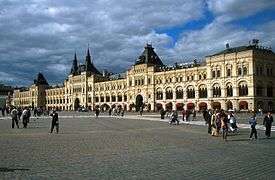
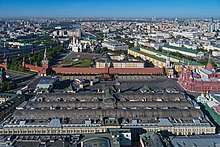
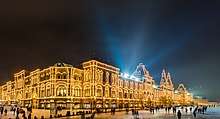
The most famous GUM is the large store facing Red Square in the Kitai-gorod area – traditionally a centre of trade in Moscow. As of 2020, the building functions as a shopping mall. Before the 1920s the location was known as the Upper Trading Rows (Russian: Верхние торговые ряды, tr. Verhnije torgovye rjady).
Moscow GUM
Design and structure
With the façade extending for 242 m (794 ft) along the eastern side of Red Square, the Upper Trading Rows were built between 1890 and 1893 by Alexander Pomerantsev (responsible for architecture) and Vladimir Shukhov (responsible for engineering). The trapezoidal building features a combination of elements of Russian medieval architecture and a steel framework and glass roof, a similar style to the great 19th-century railway stations of London. William Craft Brumfield described the GUM building as "a tribute both to Shukhov's design and to the technical proficiency of Russian architecture toward the end of the 19th century".[1]
The glass-roofed design made the building unique at the time of construction. The roof, the diameter of which is 14 m (46 ft), looks light, but it is a firm construction made of more than 50,000 metal pods (about 743 t (819 short tons)), capable of supporting snowfall accumulation. Illumination is provided by huge arched skylights of iron and glass, each weighing some 740 t (820 short tons) and containing in excess of 20,000 panes of glass. The facade is divided into several horizontal tiers, lined with red Finnish granite, Tarusa marble, and limestone. Each arcade is on three levels, linked by walkways of reinforced concrete.
History
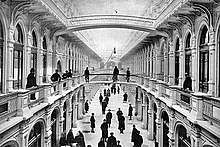
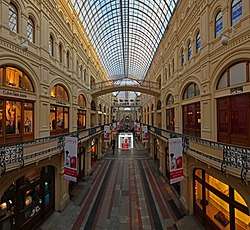
Catherine II of Russia commissioned Giacomo Quarenghi, a Neoclassical architect from Italy, to design a huge trade center along the east side of Red Square. However, that building was lost to the 1812 Fire of Moscow and replaced by trading rows designed by Joseph Bove. In turn, the current structure replaced Bove's.[2]
By the time of the Russian Revolution of 1917, the building contained some 1,200 stores. After the Revolution, the GUM was nationalised. During the NEP period (1921–28), GUM as a State Department Store operated as a model retail enterprise for consumers throughout Russia regardless of class, gender, and ethnicity. GUM's stores were used to further Bolshevik goals of rebuilding private enterprise along socialist lines and "democratizing consumption for workers and peasants nationwide". In the end, GUM's efforts to build communism through consumerism were unsuccessful and arguably "only succeeded in alienating consumers from state stores and instituting a culture of complaint and entitlement".[3]
GUM continued to be used as a department store until Joseph Stalin converted it into office space in 1928 for the committee in charge of his first Five Year Plan.[2] After the suicide of Stalin's wife Nadezhda in 1932, the GUM was used briefly to display her body.[4]
After reopening as a department store in 1953, the GUM became one of the few stores in the Soviet Union that did not have shortages of consumer goods, and the queues of shoppers were long, often extending entirely across Red Square.[5]
At the end of the Soviet era, GUM was partially, then fully privatized, and it had a number of owners before it ended up being owned by the supermarket company Perekryostok. In May 2005, a 50.25% interest was sold to Bosco di Ciliegi, a Russian luxury goods distributor and boutique operator. As a private shopping mall, it was renamed in such a fashion that it could maintain its old abbreviation and thus still be called GUM. However, the first word Gosudarstvennyi ("state") has been replaced with Glavnyi ("main"), so that GUM is now an abbreviation for "Main Universal Store".
See also
References
- Brumfield, William Craft (1991). The Origins of Modernism in Russian Architecture. Berkeley, Los Angeles, Oxford: University of California Press. ISBN 0-520-06929-3.
- Pomeratzev, Alexander. Верхние торговые ряды на Красной площади в Москве. 1890–1893 (in Russian). Russian Educational Portal. Archived from the original on 4 March 2016. Retrieved 20 April 2013.
- Hilton, Marjorie L. (2004). "Retailing the Revolution: The State Department Store (GUM) and Soviet Society in the 1920s". Journal of Social History. Oxford University Press. 37 (4): 939–964, 1127. doi:10.1353/jsh.2004.0049. ISSN 0022-4529.
- Kolesnik, Alexander. "Chronicles of Stalin's family" (in Russian). Librusek. Retrieved 20 April 2013.
- "History of GUM" (in Russian). Official GUM website. Retrieved 20 April 2013.
Sources
- Brumfield, William Craft, (1991) The Origins of Modernism in Russian Architecture, University of California Press, Berkeley, Los Angeles, Oxford, ISBN 0-520-06929-3
- English, Elizabeth Cooper (2000). "Arkhitektura i mnimosti": The origins of Soviet avant-garde rationalist architecture in the Russian mystical-philosophical and mathematical intellectual tradition", a dissertation in architecture, University of Pennsylvania
- Hilton, Marjorie L. (2004). "Retailing the Revolution: The State Department Store (GUM) and Soviet Society in the 1920s". Journal of Social History, (Oxford University Press) 37 (4): 939–964; 1127. ISSN 0022-4529
- Rainer Graefe, Jos Tomlow: “Vladimir G. Suchov 1853–1939. Die Kunst der sparsamen Konstruktion.”, 192 S., Deutsche Verlags-Anstalt, Stuttgart, 1990, ISBN 3-421-02984-9
External links
| Wikimedia Commons has media related to Moscow GUM. |